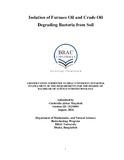| dc.contributor.advisor | Hossain, Dr. Mahboob | |
| dc.contributor.author | Mayaboti, Cinderella Akbar | |
| dc.date.accessioned | 2017-03-12T06:45:03Z | |
| dc.date.available | 2017-03-12T06:45:03Z | |
| dc.date.copyright | 2016 | |
| dc.date.issued | 2016-08 | |
| dc.identifier.other | ID 11236001 | |
| dc.identifier.uri | http://hdl.handle.net/10361/7883 | |
| dc.description | This Thesis is submitted in partial fulfillment of the requirements for the degree of Bachelor of Science in Biotechnology, 2016. | en_US |
| dc.description | Cataloged from PDF version of thesis report. | |
| dc.description | Includes bibliographical references (page 47-50). | |
| dc.description.abstract | Oil pollution is one of the major problems of the environmental issues. It is important to clean up oil spill as it causes disturbance to the balance of nature, hampering animals, plants and humans life. Many diseases, disorders and cancers are caused due to oil pollution throughout the world. Even exotic marine and terrestrial species are becoming endangered. Chemical and physical methods towards oil spillage are expensive, less effective and has other side effect on the environment. On the other hand biological process i.e. bioremediation is more effective, inexpensive and environment friendly. Microorganisms found in nature are capable of utilizing these hydrocarbons and break them down to innocuous by-products. The purpose of this study was to isolate microorganisms which were capable of using furnace oil and crude oil as sole carbon source. Four isolates were derived from two different locations and from furnace oil itself. The bacteria were individually cultured in a mineral salt broth devoid of carbon source except for furnace oil and crude oil for 7 days at 35°C. The growth of bacteria was observed from visible increase of turbidity and was enumerated by CFU/ml on nutrient agar of same composition after 7 days of culture in the broth. The four microorganisms were identified as Bacillus megaterium, Bacillus badius, Penibacillus chibensis and Aerococcus viridians through colonial morphology and biochemical tests. Among all four Bacillus badius showed higher ability to grow on both furnace oil and crude oil individually. The bacterial count for furnace oil on day 7 was 7.73 logCFU/ml and for crude oil on day 7 it was 7.76 logCFUml. Aerococcus viridans showed the next best ability to grow on both furnace oil and crude oil individually. The result on day 7 was 6.7 CFUlog/ml for both furnace oil and crude oil from 6.64 logCFU/ml and 6.69 logCFU/ml respectively on day 1. Bacillus megaterium and Penibacillus chebensis,had relatively no or little ability to grow on either of the oils. | en_US |
| dc.description.statementofresponsibility | Cinderella Akbar Mayaboti | |
| dc.format.extent | 58 pages | |
| dc.language.iso | en | en_US |
| dc.publisher | BRAC University | en_US |
| dc.rights | BRAC University thesis are protected by copyright. They may be viewed from this source for any purpose, but reproduction or distribution in any format is prohibited without written permission. | |
| dc.subject | Furnace oil | en_US |
| dc.subject | Crude oil | en_US |
| dc.subject | Bacteria | en_US |
| dc.subject | Soil | en_US |
| dc.subject | Oil pollution | en_US |
| dc.title | Isolation of furnace oil and crude oil degrading bacteria from soil | en_US |
| dc.type | Thesis | en_US |
| dc.contributor.department | Department of Mathematics and Natural Sciences, BRAC University | |
| dc.description.degree | B. Biotechnology | |

